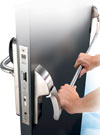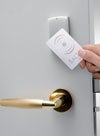

SALTO Systems preaches the wireless gospel.
Based in Oiartzun, Spain, and with offices in the UK, USA, Canada, Mexico, Germany, Portugal, Australia, the Netherlands, the UAE and Malaysia, SALTO Systems was established in 2000 with the objective of creating a new advanced state-of-the-art access control concept.
Products such as its SALTO Virtual Network have accelerated the company’s growth and this has now become the access option of choice on more than 1 000 000 doors in over 70 countries. Customer markets include airports, hospitals, government buildings, universities, corporate headquarters and hotels.
“Although our systems were originally developed to service the hospitality industry, our biggest market currently is in the tertiary education sector,” SALTO regional manager Victor Hage told Hi-Tech Security Solutions.
SALTO has its own R&D department for mechanical (locking systems), electronics and software design. All manufacturing also takes place in Spain. Because the founders of the company all have backgrounds in either the lock industry, hospitality or electronics, they have been able to identify areas of shortfall within the locking products access sector.
At the end of the 1990s new technology was introduced into access cards which allowed for the ability to read and write data programmed into them. SALTO took conventional access control and added features that are cost effective, while at the same time being adaptable and easy to install with high levels of functionality. With the SALTO system, all perimeter access is controlled in a conventional manner, while the internal doors and openings are controlled with SALTO wireless technology.
Because all data is imprinted on the card, building managers are able to control the security of their entire building, grant access privileges to individual rooms and gather audit trail data from every door – all without leaving their desk.
The system works on the following principle: A card holder enters the main entrance of a building and the appropriate data is written into his access card. Each time that he passes through an internal access point, he will wave his card across the appropriate lock reader and this entry or exit data will be automatically entered onto the card. When the card holder leaves one of the main entrances, all the data recorded on the card will be downloaded by the system onto a central controller for perusal by management or security.
An advantage to such contactless technology is that cards are less prone to wear and tear. They are also not subject to demagnetisation, which makes their operation virtually failsafe, and they are manufactured in weatherproof material to ensure repeated use even when exposed to inclement weather and moisture.
“Taking technology one step further, every new mobile phone will soon be NFC (near field communication) enabled to allow it to mimic a Mifare card and therefore be used as a hotel room key. For example, when making a hotel reservation, the hotel will send an access code to a guest’s phone which will then allow them to check into their hotel room without even having to visit the reception area. Once the visitor’s stay is over, the access code will be revoked and their phone will no longer grant access to that room or to other restricted areas such as the gym, spa or pool area for example,” Hage explained.
Because the system is completely wireless, management has the ability to deny or allow access to certain areas on a daily basis, without having to have the card in their possession. This allows for validation of the card and the exclusion of people categorised as blacklisted.
Apart from the fact that locks can be installed in five minutes (conventional card reader systems take up to four hours to install), they can also be installed in any type of door, including those constructed from wood or glass, as well as fire doors and electronic cylinder operated doors.
“We do not need to change the mortice lock and our system works with any type of lock, internationally. The large range of handles, finishes and readers means that we have a solution for any possible customer need,” Hage said.
Advanced security and convenient access management are its core values, enabling simple management of all key cards and doors in a single system. SALTO’s new AElement RFID hotel lock also features a wide range of advanced and innovative hotel management benefits including instant room move and instant extended stay abilities as well as lost card cancellation, intrusion alarm, door ajar alarm, remote opening, real-time audit trail, passage mode activation for meeting rooms and automated low battery reporting.
For staff management it can provide on-line staff tracking, real-time monitoring, dynamic master key functionality and instant master card cancellation. All master cards are uniquely assigned to the specific individual, and have no limitations to how a locking plan is conceived. The card does not need to belong to a group and you can also centrally authorise any card at random and list doors or zones with no need for grouping.
There is also no need to issue and collect staff cards every day. Staff cards can be programmed not to work at night (outside their individual time shift) and can be centrally cancelled at will at a moment’s notice, and changes to the locking schedule can be made on the fly, with no need to manually re-program locks or re-issue cards.
The system can allow for only a certain number of people to enter an area, for example into the cash or finance office. It also facilitates roll calls, visitor limited access, gym locker locking and a number of other user selected features, all on one platform.
SALTO’s new wireless DNA technology means that users can choose between the on-line and off-line world as all AElement locks are designed to be wireless ready right out of the box; users simply choose whether the functionality is activated or not. “If a user selects ‘wireless on-line’ the locks are on-line and communicate in real-time with the server. This gives you real-time control over the entire property. If they choose ‘wireless ready’, the locks communicate with the server daily on differed-time communication mode,” Hage said.

Wireless technology
The backbone of the system is a series of gateways and repeaters that act as antennas, collecting and sending information from the computer server directly to the wireless locks. One gateway can manage several electronic locks as well as repeaters, minimising infrastructure costs and maximising flexibility.
It operates on a 2,4 GHz wireless network over an 802.15.4 protocol and works with every popular mainstream RFID technology such as Mifare and DESfire, the latest versions of Mifare Plus and DESfire EV1, as well as with standard low cost hotel guest cards. Thanks to its automated self healing capabilities plus SALTO patented SVN network redundancy, if AElement should lose RF connection at any time it will automatically scan for a new connection to an alternative gateway or repeater, restoring communication and maintaining security.
AElement’s dedicated website – www.aelement.com – has a unique configuration tool that allows users to build the AElement product in a way that is exactly right for the application. “You simply select the type of mortise lock and colour finish you want, the colour of door it will be used on, the reader colour, and finally handle design and colour finish. The finished result is pictorially displayed, enabling you to create the perfect combination of style, colour and design for any environment,” Hage said.
SALTO’s largest installation to date is at the United Arab Emirates University where Phases 1 and 2 have so far installed 4400 doors. Phase 3 of this project will add another 3000 doors, making it the biggest installation of its kind in the world. Other large installations include London Heathrow Airport with over 3000 doors, Waterford Institute of Technology in Ireland with 2000 doors, T-Mobile in Austria with 1200 doors, Brunel University in the UK with 2000 doors, and the Executive Centre in Asia with 1500 doors.
Cutting cables
SALTO access control systems are designed to work in a wire free environment so there is no need to hard wire the building, allowing you to keep your original doors and locks in place. This makes installation fast, self contained and straightforward. An access control system that uses distributed intelligence in both the lock and the key to communicate wirelessly with PC-based software that makes lock re-programming or re-keying a thing of the past. Both key cards and locks can be programmed to allow or restrict access to different parts of the building.
And the information stored in the key card can be transferred to a computer to provide precise audit trail information about where and when each lock has been used including the date, time and whether access was allowed or denied. And when combined with the additional functionality provided by the SALTO Virtual Network (SVN), users can achieve 90% of the benefits of a fully on-line system for the cost of a standalone system.
Vision Systems SA, www.visionsystemssa.co.za, Johan van Steijn, +27 (0)82 804 5765, +27 (0)11 258 8880, +27 (0)86 692 8761.
For more information contact SALTO Systems, +34 943 344 550, [email protected]

© Technews Publishing (Pty) Ltd. | All Rights Reserved.